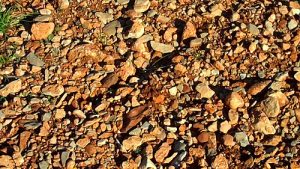Hello readers! I am currently on my maternity leave spending some quality time with my family! Enjoy this guest post from today’s featured author, William R. Cupach, Ph.D.
William R. Cupach is Professor Emeritus in the School of Communication at Illinois State University. He has certifications as Italian Wine Professional (from Italian Wine Central) and American Wine Expert (from Napa Valley Wine Academy). His email address is wrcupac@ilstu.edu.
Minerality is a ubiquitous term used by wine drinkers and critics to describe certain wines. The term is relatively new in the lexicon of wine, gaining widespread use in just the last few decades. Mineral notes are often ascribed to white wines with crisp acidity, but the term is used in reference to some red wines, albeit less frequently. A whole family of wine descriptions related to minerality has emerged, including slate, limestone, chalk, flint, wet stone, crushed rocks, gravel, graphite, silex, metallic, iodine, smoky, ocean air, oyster shell, and salty. It is tempting to characterize the flavor profile of a wine, particularly fine wine, in ways that connect to the particular soil in which the corresponding vines grew. This resonates with the concept of terroir, in which wine expresses the unique aspects of a particular vineyard site. Thus, some wines from particular locations are noted for mineral tastes that associate with elements of the soil in which the vines grow. Riesling from the Mosel is noted

Photo courtesy Flickr user Ryan O’Connell
for imparting the taste of slate; Champagne is noted for its chalky quality; and Chablis yields impressions of flint. These sensory perceptions of flavor and/or texture of the wine are presumed to derive from the corresponding rocks and minerals in the soil. But do they? Can you really taste what is in the soil?
Can You Taste Rocks and Minerals in Wine?
In discussing the relationship between soil minerals and the flavor profile of wines, it is useful to distinguish two types of minerals: geologic and nutrient (Maltman, 2018). Geologic minerals are inorganic components in soil. They generally have no smell or taste. If you were to lick a rock, what you actually would taste is the organic components from nearby plants that landed on the rock (Lewin, 2017). Moreover, grapevines are not capable of absorbing these crystalline compounds (Maltman, 2008; 2013).
Nutrient minerals, metal ions contained within geologic minerals, are essential for plant growth and development. Grapevines need components such as potassium, nitrogen, phosphorous, iron, zinc, and others. But the trace concentrations of these nutrient minerals in a finished wine are so small as to be undetectable by sensory perception (Maltman, 2013).
This is not to say that minerals and rocks have no effect on a wine. These elements can affect such things as soil drainage, temperature around the vine (rocks reflect sunshine, thereby producing heat), and perhaps the types of microorganisms that can thrive in particular soils. But the ultimate effects of rocks and minerals on wine flavor are complex and indirect. More research is needed to understand how rocks and soils can promote specific organic compounds during fermentation, from which many wine aromas and flavors are created.
Whatever minerality is in wine, it is definitely not the taste of minerals in the soil. It is a metaphorical reference to what the wine is like, not what the wine actually contains. We know there is no tobacco or cherry or chocolate in a wine, yet we find these terms useful to depict

Photo courtesy goodfreephotos
our sensory perception of it. Minerality and its related terms are used similarly—as metaphors for what we think the wine is like. But minerality seems less precise and more ambiguous as a metaphor than chocolate or cherry. When wine tasters and critics refer to minerality, what meanings do they attach to the term?
Research on the Meanings of Minerality
A number of studies using varied and sophisticated procedures have investigated the meanings ascribed to minerality in wine by consumers and experts. One conclusion is that the sensory perception of minerality is multi-modal, involving smell, taste, and mouthfeel (Heymann, et al., 2014; Parr et al. 2014). It is unclear, however, whether these modes combine to create a unified perception of minerality, or if separate, distinct notions of minerality correspond to each of these senses (Ballester et al., 2013).
Another conclusion is that minerality is an imprecise wine descriptor, which has varied meanings for different individuals. This is true for both consumers (Deneulin, Le Fur, & Bavaud, 2016) and wine experts (Deneulin & Bavaud, 2016), although less knowledgeable consumers tend to give simpler and more vague descriptions (e.g., “dry white wine”) compared to more knowledgeable consumers and wine professionals (Deneulin, Le Fur, & Bavaud, 2016; Rodrigues et al., 2015). Some consumers and wine professionals reference minerality in generic terms like terroir, soil, geology, and earth (Deneulin, Le Fur, & Bavaud, 2016; Rodrigues et al., 2015). Others use place names (e.g., Chablis, Loire Valley) or varietal names (e.g., Sauvignon Blanc) to indicate minerality (Deneulin & Bavaud, 2016; Rodrigues et al., 2015). These terms tie the sensory perception of minerality in wine to the geographical origin of its grapes, but do little to clarify exactly what the wine smells and tastes like.
Some wine experts link the presence of minerality to either a bitter or salty taste (Ballester et al., 2013; Heymann et al., 2014; Rodrigues et al., 2015). Karen MacNeil (2015), author of The Wine Bible, offers an intriguing but untested hypothesis that minerally wines activate salt receptors on the tongue, thereby amplifying other flavors, much like salt does with food. This would be an interesting proposition to research.
Perhaps the most common flavor sensation associated with minerality is acidity, which also includes descriptors such as freshness and zingy (Ballester et al., 2013; Parr et al., 2014). This is consistent with a chemical analysis conducted by Heymann and colleagues (2014) showing that wines judged higher in minerality by wine professionals and trained judges exhibited higher levels of malic acid and titratable acidity. But to associate minerality with acidic wines does not do much to specify what is uniquely mineral. Not all highly acidic wines exhibit minerality, and some wines low in acidity are characterized by minerality. Surely mineral aroma/flavor must be something more than acidity.
More specific aromas linked to minerality are largely stone-related, including flinty/gunflint/smoky, wet stone, pebble, granite, limestone, chalky/calcareous, and lead/graphite. A few other terms can be categorized as seashore related; i.e., iodine, shellfish, oyster shell, and saltiness (Ballester et al., 2013; Deneulin, Le Fur, & Bavaud, 2016; Deneulin & Bavaud, 2016; Parr et al., 2014).

Photo courtesy picryl
Perhaps owing partly to its ambiguity, not all wine consumers and professionals find the term minerality useful. In one study, 23% of consumers did not have a referent for minerality in wine (Deneulin, Le Fur, & Bavaud, 2016). There are also some wine experts who do not distinguish wines with respect to minerality and eschew using the term as a wine descriptor (e.g., Ballester et al., 2013).
Is Minerality a Useful Wine Descriptor?
The term minerality is pervasive enough in wine tasting notes that it would seem difficult to deny its utility. It certainly serves as a marketing tool. But the term is polysemous and a precise meaning remains elusive. The referents and standards for minerality are less consensual than descriptors involving fruity, floral, vegetal, and animal aromas. Minerality means different things to different people. To describe minerality as bitter or acidic or salty does not suggest anything unique beyond these fundamental tastes. Terms that refer to rocks and specific geologic minerals seem minimally helpful since in nature, these have no smell or taste. Labels like oyster shell and chalk may have as much to do with the texture of a wine as its aroma, but there is no consensus. Flinty or matchstick might be more useful, but it is quite specific and likely derives from sulfur compounds. Although individuals find minerality and its family of related terms useful to describe what they sense in a particular wine, it is not clear that using these terms conjure up the same meaning in the minds of other wine tasters. Yet minerality is entrenched in current wine vocabulary. Master of Wine Benjamin Lewin (2017) summed it up well: “Minerality is one of the most difficult qualities to define in wine, although like pornography, you recognize it when you find it.”
References
Lewin, B. (2017). Wine myths & reality (2nd ed.). Dover, DE: Vendange Press.
MacNeil, K. (2015). The wine bible (revised 2nd ed.). New York: Workman Publishing.

7 comments for “Minerality In Wine Profiles: Rocky and Slippery – A Guest Post by William R. Cupach, Ph.D.”